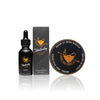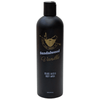Growing a beard isn’t always a straightforward process.
Sometimes it can feel like you’re taking one step forward and two steps back – especially if you’re struggling with frizzy, brittle, or damaged hair.
Lucky for you, sandalwood oil has got your back.
While it started as a popular ingredient in cologne and aromatherapy, it’s quickly become a main player in hair and beard care.
And it’s easy to see why.
In this article, you’ll learn exactly why sandalwood has gained popularity, what it can do for your beard, and how to safely use it.
Sandalwood Oil Benefits: Sandalwood oil moisturizes, softens, and soothes beards, reducing itchiness, irritation, and frizz, while promoting healthier, more manageable hair.
Types of Sandalwood: Indian sandalwood offers a stronger, earthy scent, while Australian sandalwood has a lighter, gentler aroma, ideal for sensitive skin.
Dilution & Application: Sandalwood oil should be diluted with carrier oils before applying to prevent irritation. Recommended use varies by beard length and skin type.
Moisturizing Properties: Sandalwood oil locks in moisture, helping to soften and smooth beards, making them more cuddle-friendly and easier to manage.
Safety Precautions: Always patch test sandalwood oil for allergies and dilute properly before use to avoid irritation or adverse reactions.
Types of Sandalwood Oil
Most essential oils only have one scent – but not sandalwood.
In fact, sandalwood has over 30 species that each have a unique scent.
Today we’re going to cover the two most popular options:
Indian Sandalwood
Indian Sandalwood is the first and most traditional sandalwood species.
It’s what you’re going to find at your local drugstore, pharmacy, or supermarket.
However, over-harvesting and poaching has caused the Indian Sandalwood tree to nearly become extinct. It doesn’t help that this tree needs to mature for 30 years before essential oil extraction either.
When it comes to the scent, you can think of Indian Sandalwood as that classic masculine undertone in many colognes. It has a deep woodsy, spicy, and earthy scent.
Compared to other species, Indian Sandalwood has one of the strongest and longest-lasting scents.
It’s for that reason that it’s one of the most popular species for aromatherapy. Try a high-quality product for the best results.

Australian Sandalwood
The second most popular sandalwood species comes from Australia.
This species has a lighter, creamier, and gentler scent than its brother – making it a better choice for anyone with sensitivity toward fragrances.
Compared to the 30-year process of stream distillation for the Indian Sandalwood tree, solvent extraction is used with the Australian species. This process is quicker and more cost-effective.
If you want to find the differences between these two species for yourself, pick up some pure Austrailian Sandalwood essential oil You won’t regret it.
Uses of Sandalwood Oil for Beards

Let’s face it, that sandalwood scent is fantastic – but what does it actually do?
We’re glad you asked.
Sandalwood beard oil has a long list of hair, skin, and beard benefits. Here are the top four:
Moisturizing
Other essential oils, like jojoba oil, argan oil, and grapeseed oil are well-known moisturizers.
But what about sandalwood oil?
Well, it’s no different… Sandalwood knows how to keep your beard moisturized.
That means you can forget all about that prickly frizz that’s so hard to control. Instead, you’ll have an easy-to-brush, tangle-free beard done the natural way.
Speaking of brushes, a boar bristle brush is the highest-quality product that you can use to stimulate silky soft beard growth.
And, let’s face it, who doesn't want that?
Softening
We’ve all been there…You’re sitting close to someone you love – enjoying a movie, TV show, or a good book.
That is, until they tell you that your beard is too prickly for any more cuddling.
Thankfully, sandalwood oil solves that problem for you.
It’s simple, really. A well-moisturized beard is a soft beard. And a soft beard is a cuddle and hug friendly beard.
So, if you want to get rid of those irritating prickles, you need to start using sandalwood oil.
You can also try a couple beard oils (like El Presidente) for an added punch of silky smoothness. Or, if you’re unfamiliar with beard oil, learn about it here.
Soothing
We’ve got one word for you: sandalwood.
Sandalwood oil is fully packed with antioxidants that give it antiinflamatory and antimicrobial properties – like alpha-Santalol.
That means you’ll have calmer skin underneath your beard.
So kiss those forbidden beard flakes goodbye and welcome a soothed and calmed beard. Reducing Itching & Irritation.
When first growing out your beard, it’s bound to be itchy.
Some people might tell you there’s no way around it – but that’s not true.
Thanks to sandalwood’s soothing makeup – it can calm your skin from that beginner beard grower's itch.
If you’re struggling with irritation from another product, environmental damage, or improper hygiene, applying sandalwood oil may be the cure you’re looking for as well.
Beginner and advanced beard owners alike, you should know how to grow a beard. Read our detailed guide here.

How to Use Sandalwood Oil for Beards
It’s time to apply that sandalwood oil to your beard.
But before you just into things, there are a few things you’ll want to know.
First, let’s talk about diluting sandalwood for non-irritating use:
Dilution
If you’re using any essential oils on your skin, hair, or beard, you should be diluting them.
When you skip this step, you risk irritation that may slow new beard hair growth. And nobody wants that.
Thankfully it takes less than five minutes to dilute an essential oil. All you need is the essential oil, sandalwood in this case, and a carrier oil.
If you’re wondering what carrier oil is, we’ve got you covered. A carrier oil is a gentle oil that acts as a vehicle for the essential oil you’re using. You can find a list of the best carrier oils here, including coconut oil and other rich oils.
To dilute sandalwood oil, you’ll want to mix 15 drops of essential oil with 6 teaspoons of carrier oil. This creates a 3% concentration of essential oil – which is the recommended strength for topical use.
Application
Now that you’ve diluted your pure sandalwood oil, it’s time to apply it.
But don’t just start rubbing it into your face like a madman. Now that’s a recipe for a greasy disaster.
Instead, you’ll want to follow this simple four-step process that we’ve added below.
Step 1: Start by gently cleaning your facial hair. We recommend using a specialty beard wash or warm water.
Step 2: Next, dry your beard until it is damp. If you have a shorter beard, you can pat dry with a towel. For longer beards, it’s easier to use a hair dryer on its lowest heat setting.
Step 3: Now, it's time to get out that oil. Take your diluting sandalwood oil and drop the recommended amount (which you can find in the table below) in between your palms.
Step 4: Finally, massage the oil into your beard. Start at the top of your beard and work your way toward the ends.
Essential oils get sticky. If you don’t want to get greasy, you can use a beard bush from one of our primo bundles.
Frequency and Amount of Usage
Before you get started, all you need to know is how much and how often to use sandalwood oil.
Without this knowledge, you’ll either end up with too much oil – causing beard acne – or not enough oil – which has limited benefits.
So here’s how much oil we recommend using:
For short beards |
A few drops (2-3) |
For medium length beards |
4-5 drops |
For long beards |
6+ drops |
And, how often we recommend applying it:
|
Dry skin |
1-2 times a day |
Normal skin |
5 times a week |
Oily skin |
4 times a week |

Safety & Precautions
Just because sandalwood is all-natural, doesn’t mean it’s completely risk-free.
If you’re using it too often or without diluting it, you’re bound to have problems.
Here’s what you should expect when using sandalwood oil for your beard:
Possible Allergic Reactions
Anyone can be allergic to sandalwood.
Unfortunately this isn’t an allergy you’d be aware of, unlike a food allergy.
However, if you have other allergies or easily irritated skin, we recommend starting with patch testing on visible areas of your skin. If you notice any burning, stinging, or increased redness, that most likely means you’re allergic to sandalwood and should avoid using it.
If you don’t notice any irritation after patch testing, it’s safe to use it on your beard.
Either way, we recommend starting small – and not with multiple-day treatments to begin with. Once you’re sure you’re safe from irritation, you can ramp up your usage.
Conclusion
And that’s a wrap.
Now you know why sandalwood is so much more than just an ingredient in cologne. It’s a moisturizer, hair softener, and irritation calmer – just to name a few.
For the best possible results, we recommend using sandalwood in conjunction with other beard products that use naturally derived ingredients – like beard oils and beard balm.
And, not to brag, but we’ve got quite a few of these. Check out our wide selection of high-quality and natural beard products here.


